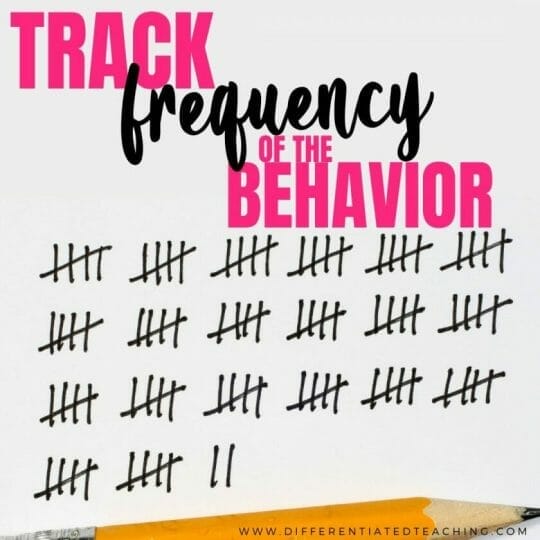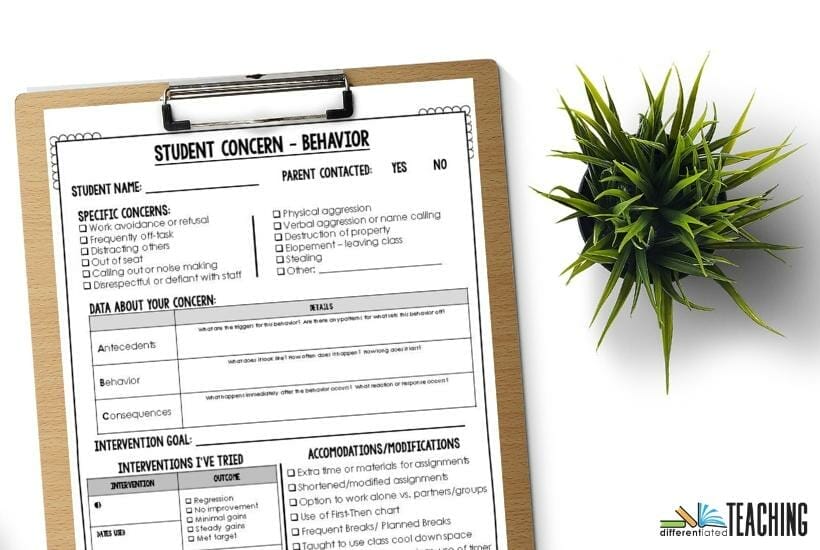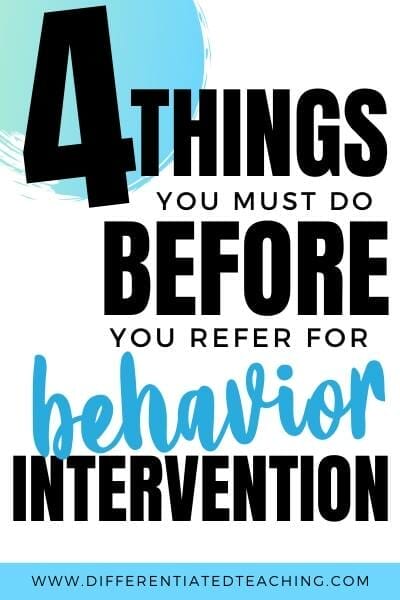The 4 things you must do BEFORE you refer a student for behavior intervention
If you’ve taught more than a year, you’ve likely run across a few behavior challenges. Sometimes it is as simple as setting up some individualized supports or create a Tier 1 behavior intervention plan yourself. Other times you work through your bag of tricks, and you need to get some additional ideas and supports.
This is where your campus student-support team comes into play. While different campuses call this team by different names, nearly all schools have a group that meets to discuss student concerns – both academic and behavioral.
If you want the best results from this meeting, here are the four things you need to do before you refer your student.

1. Review student records & connect with prior teachers.
You can get a lot of information from the student’s cumulative record and their prior teachers. Don’t feel you need to spend hours on this process. Most of the time, you can accomplish both of these tasks in 30 minutes or less.
Cumulative Record – What to look for
When reviewing the student’s records, consider academic information and any prior interventions. You’ll also want to look for recent changes in home address or medical notes.
These can all be essential pieces of information to consider sharing with your campus child-study committee when it comes to challenging behaviors.
This process should take you 10-15 minutes because most of the information can be skimmed.

Past Teachers
If you’re lucky enough to have a student who was at your school last year, find 10-15 minutes to sit down and chat with their teacher from last year. Sometimes things don’t get documented well, or documentation doesn’t get passed on. It can be helpful to know if the prior teacher saw similar behaviors and what worked or didn’t work for them.
2. Collect data on the behavior.
Unlike academics, many students with behavior issues are referred to RTI with very little data documenting the concerns. This is usually because challenging behavior tends to create more disruption in the classroom and causes more of an emotional response from us, as teachers meaning the paperwork gets submitted before all the data has been collected.

Unfortunately, this can lead to some frustrations at your RTI or MTSS team meeting. At best, you will get an intervention MIGHT help. At worst, you might be asked to spend several weeks collecting data and come back. One way to save yourself the trouble is to be sure you’ve collected adequate data and bring it with you to your meeting.
Here’s the specific data you’ll want to make sure you’ve documented:
- the concerning behavior(s) explained objectively
- any triggers you’ve identified
- interventions or things you’ve already tried & how they worked
By collecting this information before you go to your campus RTI team, you’ll be able to spend the meeting focusing on the behavior and how to resolve it rather than trying to piece together the mitigating factors in the meeting. You’ll also be more likely to create a plan that creates change because the team can select the next steps based on the patterns in the data.
Here’s a bit more about what you’ll want to include in your documentation and some easy ways to collect this data.
Concerning Behaviors
This one is typically the easiest part of the documentation process. What behavior have you been seeing? Common examples referred to the RTI team include:
- physical or verbal aggression toward teachers or peers
- work refusal
- off-task or disruptive behavior
When it comes to documenting these behaviors, you’ll want to try your hardest to be both clear and objective. Focus on what the behavior looks like, rather than how it makes you feel or how you think the child is feeling when he or she is displaying these behaviors.
You’ll also want to record information about the frequency, duration, latency, and intensity of the behavior. Here are some guiding questions that can help you identify what to document.
Frequency – How often is the behavior happening? This might be the number of instances per hour, day, week, or month depending on what you are tracking.
If you’re not sure how often it is happening, it can be helpful to spend a week or two tracking this before referring the student.
Frequency data is the most often used type of data, and it will likely be asked about in your RTI meeting.

How to track it: A simple system can be a daily post-it note that you add a tally to each time the behavior occurs. If the behavior is especially frequent, you can divide the sticky note in two (or more) and have each section be a different chunk of the day.
Intensity – This is the magnitude, or force, of the behavior. Honestly, most behaviors won’t require intensity data. However, this data can help create and monitor interventions for specific actions like noise-making or volume control or acts that are harmful to self or others.
How to track it: This is typically more subjective and is done using a rating scale. If you’re looking to get RTI supports with behavior where intensity data would be helpful, I would recommend reaching out to an interventionist or special education teacher for support.
Duration – How long does the behavior last? For most things, this will be tracked in seconds or minutes. This can be helpful for issues like tantrums or being out of their seats.
How to track it: This can be easily determined by wearing a timer and starting it when the behavior occurs. Hit stop when the situation ends and record the time before resetting it.

Latency – This is the time that passes between a prompt and the behavior. For example, when prompted to start an assignment, how long does it take the student to do so.
How to track it: A timer is a great way to follow this. When you give the directive, start the timer. When the student exhibits the behavior, stop the timer. Do this without informing the student or making it a big production to get a better understanding of the behavior.
Antecedents
When you’re thinking about antecedents, you’re trying to connect what might be the trigger for the behavior you’re seeing. When you’re collecting data on the behavior, it can be helpful to write a short sentence about what was happening right before it occurred.

If you’re reviewing already collected data, here are some guiding questions to help you explore antecedents:
- Are there specific days or times when the behavior seems to occur more frequently? If so, what is going on during these times?
- Are there specific days or times that the student is most successful? What is going on during these times?
- Can you identify any specific tasks (i.e., seatwork, group work, whole class lessons, etc.) that typically result in the behavior occurring?
- Do you notice any academic gaps or inconsistencies that might connect with when the behavior occurs?
The overall goal of analyzing antecedents is to look for patterns in what happens exactly before the behavior occurs. This can help you identify the trigger and goal the behavior is trying to achieve.
Consequences
This is the action or response given to the behavior. Think about this as the immediate response to what the student says or does. In this situation, the consequence is NOT necessarily punishment.
You might be able to identify some responses that seem to work well or cause the student to escalate. However, it can be really helpful to have a colleague come in and do a short observation in your room to help you identify the consequences. While it may seem uncomfortable at first, the goal of this process is to get to the bottom of WHY the behavior is happening so you can get things headed in the right direction.
Once you have the complete A-B-C (antecedent – behavior – consequence) picture, it can be easier to identify the function of the behavior and plan a successful intervention.

You can, however, hold off on this step until you meet with the campus SST Team if you’ve got a good amount of data and information to share at the meeting or can’t find someone to come observe in the classroom. Often times, a member of this team can be of assistance collecting this type of data.
Interventions You’ve Tried
The big idea here is just to document what you’ve tried and how successful it has been. This can help the team better determine what steps need to be taken.
Consider any interventions you’ve used, and be sure to document how long you implemented them. This is important because sometimes the behavior will escalate before it improves.
Free Student Behavior Concern Documentation Form
If you want to keep things easily organized, you can track all this data on my behavior concern form. It’s easy to take with you to your SST meeting, and it is entirely focused on behavior.
Enter your email to grab a free copy of both the academic and behavior documentation forms. Collect all the important data you need and confidently enter your student-support team meeting ready to discuss and plan interventions.

3. Connect with other teachers who support the student
It is helpful to connect with specials teachers or other campus staff who support this student.

Find out if other teachers working with the child are seeing the same behaviors in their classrooms. If they are, ask them to record some information about what they are seeing so that you can include it in your referral to the campus intervention team.
It can also be helpful to let them know you plan to refer the student to your campus intervention team. With behavior, everyone who works with the student must agree to implement any interventions that are included in the child’s plan. Giving the child’s other teachers a heads up can be an essential step to make sure everyone is on the same page.
4. Connect with the student’s parents or guardians.
Be sure to let the student’s parent or guardian know you’re going to be referring the student for discussion in an SST meeting. If the behaviors are enough to warrant this step, you’ve likely already been in regular contact with the child’s family.
If you haven’t reached out, start by picking up the phone and reaching out about the behavior. Try to keep this call friendly by letting the parents know a few of the positives you see in their child, and then discuss the behavior and determine whether they’re seeing similar things at home.
If they are, it can be helpful to know how they are managing it. It can also be beneficial to know if any significant changes are going on at home, as sometimes these can bring about behavior changes.

Either way, you’ll want to let the parents know you want to connect with a team of educators on your campus who can help you identify some new strategies for best supporting their child. Explain that while their kiddo is fantastic, right now, the behaviors are interfering with their ability to do their best in school.
Focus on how the team will help YOU so you can better support their kiddo. Phrasing it this way can prevent ruffling feathers and hurt feelings. Even the most challenging kiddos are someone’s baby, and it hurts to hear that your baby is struggling.
Next Steps
Once you’ve made sure you’ve got data and connected with colleagues and the student’s family, you can feel confident that taking the next steps and referring the student to your campus RTI team is the right move.
If you enjoyed this article and you’re looking for more support with behavior and behavior interventions, check out these articles:









